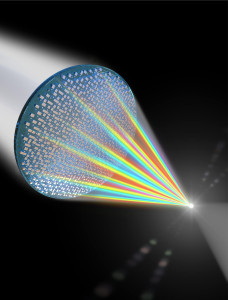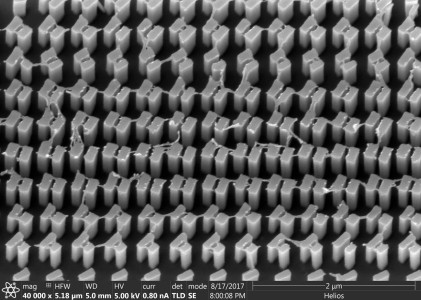
WHY THIS MATTERS IN BRIEF
Today’s VR headsets are still low resolution and big, this technology would reduce them to just millimeters thick and make UHD resolution the norm.
If wearing a Augmented Reality (AR) glasses or Virtual Reality (VR) headsets is ever to become commonplace then hardware manufacturers like HTC and Oculus will ideally need to figure out how to make the devices lightweight, small and transparent, the latter of which is something that Google and HTC is trying to do, while making sure that their images are sharp and crystal clear. But unfortunately this challenge isn’t easy to overcome, and exposes a fundamental limitation in optics and the physics of light itself. Today all conventional lenses, like the ones in your smartphone, are made from curved glass that focus different wavelengths of light in different locations, and it’s how these lenses are laid out that determines if the images you see and the photos you take are blurry or not.
Now though researchers at Harvard University and the University of Waterloo have found a way to make flat, transparent, ultra-thin lenses that can create crystal clear images by tapping up a type of nano-technology called a Metalense, that I’ve talked about before, that not just has the advantage of being nanoscale small, but that can also deliver crystal clear images across a wider spectrum of light than traditional lenses without the need for all those extra bits of bulky, heavy glass.
Source: Harvard University
For centuries the lenses for cameras, glasses, telescopes, and so on, have been made by grinding glass into a rough curved shape and then polishing it to cleanly and clearly bend light. However, these lenses can’t focus light of every colour on the same point which is why you need lots of them in a traditional camera or headset.
To reduce this effect, commercial lens manufacturers construct complicated optical devices with many separate lenses, each precisely ground into curves and aligned to focus the range of wavelengths in just the right place, with the end result being that they inevitably end up with large, heavy and complex lenses that noone would want to wear as part of a VR experience. And this is the problem that these new metalenses solve.
To replace these enormous rigs the team started with a millimetre thick sheet of regular flat glass, and then they placed a layer of carefully designed rectangular nanostructures, a million times thinner than the glass layer, and made of titanium dioxide which is totally transparent to visible light, on top of it.
The nanostructures were designed to bend incoming light rays by increasingly greater angles the farther they hit the metalens from its center so that all rays are focused in the same spot. Then to secure the nanostructures onto the glass substrate they used the same type of lithographic process made to manufacture computer chips.
In 2016 the same team showed that using flat glass with nanostructures could focus light of one specific colour just as well as a traditional curved lens. But in that research what they made suffered from the same age old problem as curved glass -each colour focused on a different location, and to have their new flat lenses form high quality images, all the light, regardless of its colour, has to focus on the same point.
In their latest work the team designed a more sophisticated set of nanostructures that bend the light at higher angles the farther from the center of the metalense they are, but with an important modification – after leaving the metalens, the light has to travel to the focus point, which is farther from the edges than it is from the center of the lens. And it’s this that allowed them to create their sharp images.
Now the team hopes that their technology can be used not just to help create ultra-thin AR and VR glasses and headsets, but also nanoscale smartphone cameras, and much more.


















